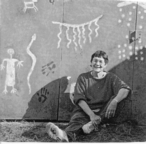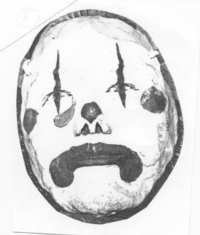JOURNAL OF THE FELLOWSHIP OF QUAKERS IN THE ARTS
Issue #20, Winter 2000-2001
The Healing Art

An
Interview with Marybeth Webster
by Diana Day
"The aesthetic, the surprises, the re-visioning possible through art are essential to soul-making." —MW
WHO AMONG FRIENDS HAS NOT QUESTIONED the place and purpose of art in our lives? Is the very act of creating self-seeking? Must we justify the time we spend making art by blending it with community service?
Marybeth Webster has been an artist, a therapist and is now a Registered Art Therapist. She has no pat answers to the queries above, but her life offers an interesting example of how one leading can quite literally lead to another.
She first gained insight into the nature and treatment of illness when she contracted rheumatic fever as a teenager. Her doctor confided to his young patient that he'd always wanted to be a psychiatrist, because most sicknesses were of the "heart", not the body. His treatment of Marybeth's rheumatic fever not only left her well, but sent her forward with a different understanding of healing.
At this point, however, her strongest inclination was toward art. Growing up in Grand Junction, Colorado, she'd drawn ever since she could hold a pencil. Her mother was of a practical bent and told Marybeth "that's a nice hobby, dear, not something you do for a living."
As a result, Marybeth found herself in junior college (while her brother was sent to Dartmouth) taking courses in business and teaching so she could earn a living "if you were widowed". Could she change one thing in her life, it would be to have gone to the best possible art school instead.
MARYBETH EVENTUALLY GOT HER ART EDUCATION, but it took a circuitous path that blended art training with experiences that would later move her to become an art therapist.
She married a man who spent seven years in graduate school at Oregon State University. Some of his professors admired Marybeth's botanical drawings so much they helped her apprentice to a scientific illustrator. Not only did this provide the art lessons she sought, but actually allowed her to earn enough to support herself and her husband through his years of study.
Once out of school, his first job took them to Costa Rica. By then Marybeth had two small children and found herself living on a banana plantation close to the construction of the Pan-Am highway. She began to paint the orchids that fell with the clearing of the 300 foot tall trees. She also began doing insect drawings for the United Fruit Company.
From Costa Rica the family moved next to Honduras, where a fine watercolorist gave Marybeth further lessons. She was soon teaching art for the US Information Service. She later studied at the Art School in Tegucigalpa and was tutored in composition and color. Marybeth became the only exhibiting, selling watercolorist in the Republic of Honduras.
By the time she and her husband moved to Hawaii, she had four children. Half the people in Hawaii seemed to be artists. Undeterred, she began drawing portraits of the lovely faces there, and worked for the Bishop Museum and the East-West Center as an illustrator.
While her work as an artist was progressing satisfactorily, life at home had become unbearable. Her husband was abusive, and when she finally found the courage to leave him, she says she was "barely alive".
In an effort to recover her sense of self, Marybeth turned to counseling others. After her divorce she worked as a counselor at a private school, then founded her own Summerhill-type secondary school, where she taught art, psychology and creative movement.
 STILL,
THERAPY AND ART WERE TWO FORCES in her life that had not
fully converged. Marybeth's spiritual search, including her introduction to Quakerism, played a part
in the joining.
STILL,
THERAPY AND ART WERE TWO FORCES in her life that had not
fully converged. Marybeth's spiritual search, including her introduction to Quakerism, played a part
in the joining.
She had been raised in the Episcopal church, but became an angry atheist at age 13 when a priest attempted to molest her. Many years later, after her first marriage, Marybeth met a Unitarian minister/lawyer whose views reflected her own. They married, but when he lost his pulpit amid controversy from those who felt he was too radical, she began to attend a Congregational worship group. It was made up of Shinto, Buddhist and Agnostic worshippers, but she was troubled by the Christocentric language she encountered there. By this time, her second marriage had become a source of further conflict and the two divorced.
A door shuts, a window opens. Marybeth embarked on a peace pilgrimage "in a desperate desire to find a reason to live." She decided to do research on peacemakers, a project that led her to the Religious Society of Friends. She began to attend Quaker worship in Hawaii and continued once she returned to the mainland.
She had applied to the American Humanistic Psychology Association for a grant for her research. When it didn't come through, she used the settlement from her divorce to fund it herself. She made a pilgrimage through 29 states as well as New Zealand, Australia and Canada. Along the way she contacted Quakers through the Traveling Friends Directory. Her journey included six days at Pendle Hill and meetings in about 15 states, where she interviewed dozens of Quaker peacemakers. Eventually the AHPA sponsored the multi-media show she created with her findings, which she presented at their conferences.
Once settled in California, she attended various Quaker meetings but it took a few years before she was truly convinced. "I admired the governance methods," she recalls. "I'd studied communities, the Movement for a New Society, all kinds of Humanistic Psychology decision-making models. The Quakers had the best one and I've found nothing better. I liked the language referring to the Light, the Spirit, the 'more-than-merely-human' as I came to refer to the awesome 'other', sensed but too powerful, too unfathomable to name.
"It has taken a while to recover from overly high expectations about Quakers. I 'pedestalled' many until I realized that that contradicted 'What sayest thou?' and the requirement to look inside, experience, not swallow whole or derive my beliefs from outside."
Over time she became a convinced Quaker and a member of the Friends Meeting in Grass Valley, California. Whether coincidentally or not, art has since ceased to be a job or a hobby for her. It's now a tool for healing.
WHEN ASKED WHAT SPECIFICALLY OPENED HER WAY to doing grief, divorce and dementia counseling, she responds, "Pain! Two divorces with the resultant suffering of my four children and three stepchildren made me want to help other divorcing families do it better than we had done.
"I became a full orphan in 1989 and started the Art Therapy training one year later, thus the focus on grief as a core issue in most dysfunction."
She has used art therapy in the context of interventions for people in crisis, whether battered women, divorcing couples, emotionally disturbed children/ adolescents or stroke/head injury victims. Art has proved an excellent means of bringing buried material to consciousness, improving cognition and encouraging socialization. And for victims of stroke and head injuries. Through art, the hand-eye-brain connections help re build or circumvent damaged synapses.
For people with full cognition, Art Therapy "goes beyond and beneath words," she says. "It's a gentle, fast, insight-filled path to individuation. I use words, and people process their work using words, but the picture often says far more than the words. The little 'mistakes', color choice, line quality are all meaningful clues to interior truths.... Children's drawings are now being admitted into court in abuse cases, since the art permits the child to 'tell' what happened when they can't or won't talk about it."
Lately Marybeth finds herself working more with dementia patients. She felt that gerontology was a good area for Art Therapy pioneering in the town where she'd decided to live, with its large population of elderly people. A relative of a stroke patient she worked with referred an accident victim with a head injury, and the similarities with stroke and Alzheimer's and other dementias began to coalesce.
What sort of art does she see among those suffering dementia? "Depending on the stages, the art will be increasingly abstract with repetitive forms—pointillist, stripes, concentric shapes. The colors are usually unmixed, so offering a varied palette may interest or may irritate someone used to a primary palette. Some delight in mixing colors and forget to paint!...If asked to give their piece a title, the most poignant, funny or accurate words can come out...often fairly regressed people will be able to draw a favorite pet or their childhood."
FOR ARTISTS, PERHAPS THE MOST INSPIRATIONAL distillation from her experiences is Marybeth's perception of the "Muse" as the Light Within.
"The idea came to me in a Meeting for Worship, after a fairly Christian Friend had spoken about gratitude to God for his cow and his garden, and another spoke of the inspiration of flying over America. So what was the source of my feelings of worship or awe? The total unselfconsciousness of artistic inspiration, the breathing in of form, color, meaning, imagination—these could be subsumed under the word 'Muse'. And why not? In-spired, in-spirited, graced with new meaning out of external material poured into alchemical vats of all the human powers...
"I then 'saw' my Muse. She is old, a suffering war victim of some other culture; she rises from the ground, tearstained face glowing as she makes a handprint on a ruined wall. I did a collage workshop last year called 'Finding Your Muse'. The glow of 40-some faces as they describe their process and the meaning of their piece is worship, is the universal connection, is continuing revelation embodied!"
Given her background, Marybeth feels somewhat exasperated with Friends who believe that making art is selfish or self-seeking. "I ask," she says, "how is making art any more or less selfish than attending to good hygiene and nutrition, to self-care of any kind? Is not commitment to something greater than the self, spiritual?"
Diana Day is a painter and a member of the Macon (GA) Quaker Worship Group.
Types & Shadows is published quarterly by the Fellowship of Quakers in the Arts. Subscriptions are available through membership in the FQA.
Top | T&S Archive | Subject Index | FQA Home Page
Join FQA | Contact usThis page added July 2002